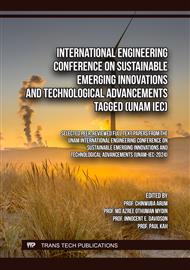[1]
B. Paden, M. Čáp, S. Z. Yong, D. Yershov, E. Frazzoli, A survey of motion planning and control techniques for self-driving urban vehicles, IEEE Transactions on Intelligent Vehicles, 1 (2016) 1–27
DOI: 10.1109/TIV.2016.2578706
Google Scholar
[2]
G.M. Brindha, K.K. Karishma, A. Mukhesh, K.K.N. Veeramani, M. Mohamed, Accident prevention by automatic braking system and multisensors, International Journal of Advanced Science and Technology, 29 (2020) 873-879
Google Scholar
[3]
C. Bloom, J. Tan, J. Ramjohn, L. Bauer, S. Clara, C. Bloom, Self-driving cars and data collection, Proceedings of the self-driving cars and data collection : Privacy perceptions of networked autonomous vehicles, Thirteenth Symposium on Usable Privacy and Security, Soups, (2017) pp.357-375 https://www.usenix.org/conference/soups2017/technical-sessions /presentation/bloom
Google Scholar
[4]
G. Lie, R. Zejian, G. Pingshu, C. Jing, Advanced emergency braking controller design for pedestrian protection oriented automotive collision avoidance system, Scientific World Journal. Volume 2014, Article ID 218246 (2014) 11 pages
DOI: 10.1155/2014/218246
Google Scholar
[5]
P. Seiler, B. Song, J. K. Hedrick, Development of a collision avoidance system, SAE Technical Papers (1998)
DOI: 10.4271/980853
Google Scholar
[6]
J. Yun, M. H. Song, Detecting direction of movement using pyroelectric infrared sensors, IEEE Sensors Journal, 14 (2014) 1482–1489
DOI: 10.1109/JSEN.2013.2296601
Google Scholar
[7]
F, Hau, F. Baumgärtner, M. Vossiek, The degradation of automotive radar sensor signals caused by vehicle vibrations and other nonlinear movements. Sensors (Switzerland), 20 (2020) 1–17
DOI: 10.3390/s20216195
Google Scholar
[8]
H-R. Chen, FMCW Radar jamming techniques and analysis, Thesis; Naval Postgraduate School, Monterey, California, 2013. http://hdl.handle.net/10945/37597
Google Scholar
[9]
L. Koval, J. Vaňuš, P. Bilík, Distance measuring by ultrasonic sensor. IFAC-PapersOnLine, 49 (2016) 153–158
DOI: 10.1016/j.ifacol.2016.12.026
Google Scholar
[10]
J. Steinbaeck, C. Steger, G. Holweg, N. Druml, Next generation radar sensors in automotive sensor fusion systems, Symposium on Sensor Data Fusion: Trends, Solutions, Applications, SDF (2017)1–6
DOI: 10.1109/SDF.2017.8126389
Google Scholar
[11]
N. Li, C. P. Ho, J. Xue, L. W. Lim, G. Chen, Y. H. Fu, L. Y. T. Lee, A progress review on solid-state LiDAR and Nanophotonics-based LiDAR Sensors, Laser and Photonics Reviews, 16 (2022) 1–24
DOI: 10.1002/lpor.202100511
Google Scholar
[12]
B. Behroozpour, P. A. M. Sandborn, M. C. Wu, B. E. Boser, Lidar system architectures and circuits, IEEE Communications Magazine, 55 (2017) 135–142
DOI: 10.1109/MCOM.2017.1700030
Google Scholar
[13]
S. Chen, S. Zhang, J. Shang, B. Chen, N. Zheng, Brain-inspired cognitive model with attention for self-driving cars, IEEE Transactions on Cognitive and Developmental Systems, 11 (2019) 13–25
DOI: 10.1109/TCDS.2017.2717451
Google Scholar
[14]
G. Kühnle, H. Mayer, H. Olbrich, W. Steffens, H-C, Swoboda, Low-cost long-range radar for future driver assistance systems, ATZautotechnology, 3 (2003) 76–80
DOI: 10.1007/bf03246785
Google Scholar
[15]
L. C. Chin, S. N. Basah, S. Yaacob, M. Y. Din, Y. E. Juan, Accuracy and reliability of optimum distance for high performance Kinect sensor. Proceedings - 2015 2nd International Conference on Biomedical Engineering, ICoBE 2015, March, 1–7
DOI: 10.1109/ICoBE.2015.7235927
Google Scholar
[16]
P. J. Navarro, C. Fernández, R. Borraz, D. Alonso, A machine learning approach to pedestrian detection for autonomous vehicles using high-definition 3D range data, Sensors (Switzerland), 17 (2017) 1-20
DOI: 10.3390/s17010018
Google Scholar
[17]
M. Ariyanto, G. D. Haryadi, M. Munadi, R. Ismail, Z. Hendra, Development of low-cost autonomous emergency braking system (AEBS) for an electric car, Proceeding - 2018 5th International Conference on Electric Vehicular Technology, ICEVT 2018, 167–171
DOI: 10.1109/ICEVT.2018.8628442
Google Scholar
[18]
K. Pearson, Mathematical contributions to the theory of evolution—III. Regression, heredity, and panmixia, Philosophical Transactions of the Royal Society of London. Series A, Containing Papers of a Mathematical or Physical Character, 187 (1896) 253-318.
DOI: 10.1098/rsta.1896.0007
Google Scholar


